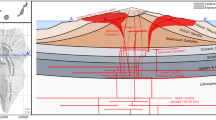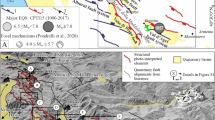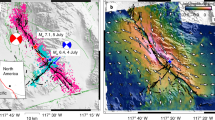Abstract
AN analysis of the original orientation of Precambrian dykes has produced a nonrandom pattern that implies the existence of a Precambrian stress field of global extent. In general, dyke intrusion tends to occur in a north–south orientation, and is concentrated in low latitudes. This distribution has many similarities to the present distribution of sheeted diabase complexes of present day oceanic ridge crests, and may reflect the persistence of the same stress field throughout geological time. Other evidence in favour of the existence of this stress field can be found in tectonic motions or geological features that exhibit a symmetrical distribution relative to the Earth's rotational axis. For example, Moore1 showed that the preferred orientation of spreading axes is directed north–south with a secondary maximum orientated east–west. Active transform faults exhibit a unimodal east–west distribution. A former study of recent continental rift valleys has revealed a preferred north–south orientation of fracturing. Cainozoic grabens, most of which have not been significantly rotated by plate movements following their formation, exhibit an especially strong peak within 10° of north2. Here we describe our analysis of preferred fracture orientations using the trends and directions of Precambrian dykes. A central point of this study is the assumption that regional dyke patterns record fractures which result from regional stress fields operative at the time of dyke intrusion. Escher et al.3 have confirmed the above assumption using geological evidence from the Amitsoq dykes of Greenland.
This is a preview of subscription content, access via your institution
Access options
Subscribe to this journal
Receive 51 print issues and online access
$199.00 per year
only $3.90 per issue
Buy this article
- Purchase on Springer Link
- Instant access to full article PDF
Prices may be subject to local taxes which are calculated during checkout
Similar content being viewed by others
References
Moore, G. W. Geology 1, 99–101 (1973).
Ranalli, G. & Tanczyk, E. I. J. Geol. 83, 526–531 (1975).
Escher, A., Jack, S. & Watterson, J. Phil. Trans. R. Soc. Lond. A280, 529–541 (1976).
Strangway, D. W. J. geophys. Res. 66, 3021–3032 (1961).
Irving, E. & Hastie, J. Geomagnetic Ser. No. 3 (Earth Physics Branch publications EMR, 1975).
Evans, M. E. J. geophys. Res. 73, 3261–3270 (1968).
Author information
Authors and Affiliations
Rights and permissions
About this article
Cite this article
MORRIS, W., TANCZYK, E. A preferred orientation of intrusion of Precambrian dykes. Nature 275, 120–121 (1978). https://doi.org/10.1038/275120a0
Received:
Accepted:
Published:
Issue Date:
DOI: https://doi.org/10.1038/275120a0
Comments
By submitting a comment you agree to abide by our Terms and Community Guidelines. If you find something abusive or that does not comply with our terms or guidelines please flag it as inappropriate.



